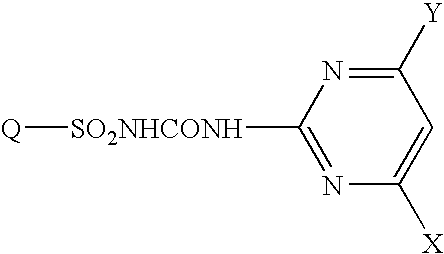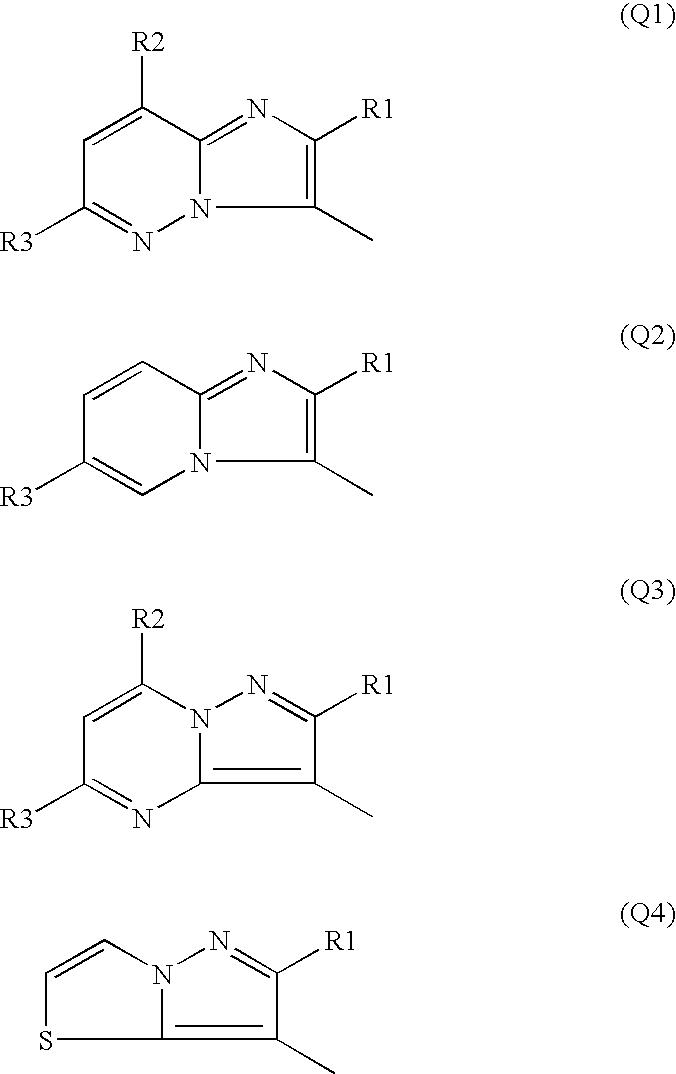Fused heterocyclic sulfonylurea compound herbicide containing the same and method of controlling weed with the same
a heterocyclic sulfonylurea and herbicide technology, applied in the field of new herbicides containing fused heterocyclic sulfonylurea compounds, can solve problems such as difficult control of weeds, and achieve the effects of high weeding effect, wide weeding spectrum, and high weeding
- Summary
- Abstract
- Description
- Claims
- Application Information
AI Technical Summary
Benefits of technology
Problems solved by technology
Method used
Image
Examples
reference example 1
Synthesis of 6-ethyl-2-methylimidazo[1,2-b]pyridazine
6-Chloro-2-methylimidazo[1,2-b]pyridazine (5.00 g, 29.8 mmol) and [1,3-bis(diphenylphosphino)propane]nickel (II) dichloride (0.08 g, 0.15 mmol) were suspended in dry ether (40 ml)-dry THF (20 ml) and then stirred under ice-cooling, during which a solution of ethylmagnesium bromide in ether (3 M, 15 ml, 45 mmol) was added dropwise thereto over 5 minutes (internal temperature 10° C. or less). The temperature of the reaction solution was increased to room temperature, and the mixture was stirred at the same temperature for 2 hours and under reflux with heating for 3 hours. The reaction solution, while being stirred, was left and cooled to room temperature, and water (30 ml) was added little by little. Further, the reaction mixture was stirred at room temperature and adjusted to about pH 5 to 6 with conc. hydrochloric acid. The organic layer and the aqueous layer were separated from each other, and the aqueous layer was extracted ...
reference example 2
Synthesis of 6-ethyl-2-methylimidazo[1,2-b]pyridazin-3-sulfonamide
6-Ethyl-2-methylimidazo[1,2-b]pyridazine (2.70 g, 16.7 mmol) was dissolved in 1,2-dichloroethane (30 ml), and chlorosulfonic acid (1.27 g, 18.5 mmol) was added thereto under stirring at room temperature, and the mixture was stirred for 5 hours under reflux. Then, the reaction solution was cooled to about 70° C., and triethylamine (2.38 g, 23.5 mmol) was added dropwise thereto over 1 minute. After dropping, the reaction solution was stirred for 20 minutes under reflux. Thereafter, the reaction solution was cooled to about 70° C., and phosphorus oxychloride (3.86 g, 25.2 mmol) was added dropwise thereto over 1 minute. After dropping, the mixture was stirred for 2 hours under reflux. The reaction solution was left and cooled to about 50° C., and poured into 50 ml warm water (about 50° C.). The mixture was stirred for 5 minutes, and the organic layer was separated. The aqueous layer was extracted with chloroform (50 m...
reference example 3
Synthesis of 2-chloro-6-n-propylimidazo[1,2-b]pyridazine
2,6-Dichloroimidazo[1,2-b]pyridazine (1.6 g, 8.5 mmol), [1,3-bis(diphenylphosphino)propane]nickel (II) dichloride (catalytic amount) and dehydrated tetrahydrofuran (20 ml) were introduced into a 100-ml three-necked flask under a nitrogen stream and stirred under ice-cooling, and a solution of propylmagnesium chloride in tetrahydrofuran (2 M, 6.4 ml, 12.8 mmol) was added dropwise thereto at 10° C. or less. After dropping, the mixture was stirred for 1 hour at the same temperature, for 1 hour at room temperature and for 2 hours at 50 to 60° C. After the reaction was completed, the reaction solution was left and cooled, and water (50 ml) was added thereto, and the mixture was stirred and extracted with ethyl acetate (20 ml×2). The organic layers were combined, washed with water, dried over magnesium sulfate and concentrated, and the residues were purified by silica gel column chromatography (hexane:ethyl acetate=2:1) to give t...
PUM
 Login to View More
Login to View More Abstract
Description
Claims
Application Information
 Login to View More
Login to View More - R&D
- Intellectual Property
- Life Sciences
- Materials
- Tech Scout
- Unparalleled Data Quality
- Higher Quality Content
- 60% Fewer Hallucinations
Browse by: Latest US Patents, China's latest patents, Technical Efficacy Thesaurus, Application Domain, Technology Topic, Popular Technical Reports.
© 2025 PatSnap. All rights reserved.Legal|Privacy policy|Modern Slavery Act Transparency Statement|Sitemap|About US| Contact US: help@patsnap.com



